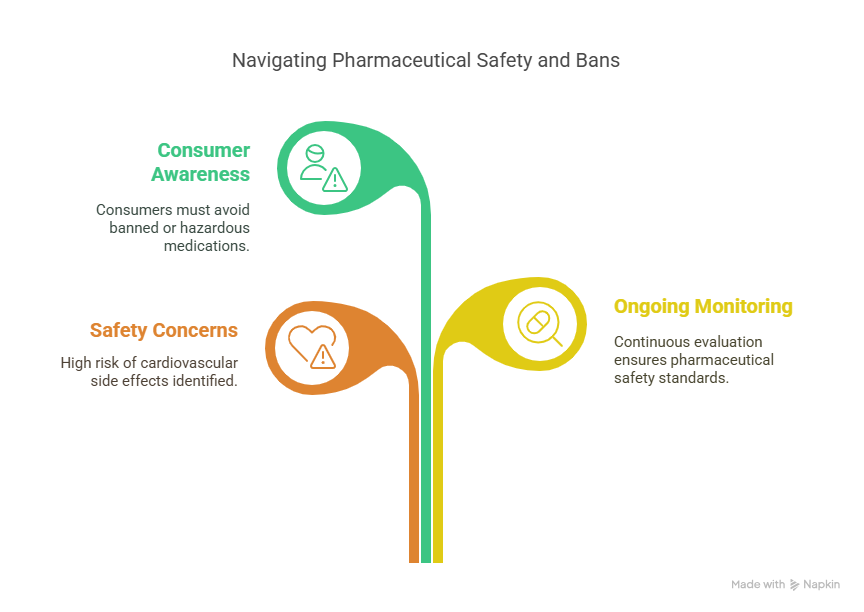Imagine taking a prescription medication that you trust, only to discover later that it’s been banned due to harmful side effects.
This is a harsh reality for many in India, where certain drugs have been prohibited due to safety concerns. Staying informed about banned medicines is crucial for your health and safety.
The Indian government regularly updates the list of banned drugs to protect citizens from potentially dangerous therapies. Making educated decisions regarding your health can be facilitated by being aware of the items in this list.
The list of medicines that are restricted in India will be explained in this post, along with the reasons behind the prohibitions and precautions you can take.
Comprehending India’s Medicine Bans
Consumers must comprehend the legal basis underlying India’s medication restrictions. There are many medications offered to consumers in India’s enormous and varied pharmaceutical sector. Regulators have taken action against several medications because they are not all safe or effective.
The Central Drugs Standard Control Organization’s Function
In India, the Central Drugs Standard Control Organization (CDSCO) is essential to drug regulation. It is in charge of ensuring regulatory compliance, doing inspections, and authorizing new medications. The Ministry of Health and Family Welfare oversees the CDSCO, which strives to guarantee the quality, safety, and efficacy of medications sold in India.
Reasons for Drug Prohibition
India prohibits medicines for a number of reasons, including:
- Safety issues because of negative reactions
- Ineffectiveness as demonstrated by clinical trials
- Existence of dangerous or prohibited chemicals
These factors demonstrate the strict regulations that are in place for pharmaceuticals in India.
The Regulation of Medicines by Law
The 1940 Drugs and Cosmetics Act and the 1945 Rules serve as the main foundation for the legislative framework that governs medicine regulation in India. The basis for regulating pharmaceuticals, including their approval, production, and distribution, is provided by these laws. To guarantee adherence, the CDSCO enforces these rules.
India’s Complete List of Banned Medicines
In order to make educated decisions regarding their health, customers must be aware of which medications are prohibited in India. The Indian government has been aggressively attempting to remove dangerous and ineffective medications off the market through its regulatory agencies.
Drugs with Fixed Dose Combinations (FDC)
Drugs classified as Fixed Dose Combinations (FDCs), which include two or more active components, have drawn a lot of regulatory attention. Because of worries about their safety and effectiveness, many FDCs have been outlawed. For example, it was discovered that certain FDCs used to treat pain and fever have insufficient safety profiles.
The government’s attempts to guarantee that the public has access to only safe and effective pharmaceuticals are demonstrated by the prohibition on these FDCs.
Antimicrobials and Antibiotics
There are serious worries regarding resistance as a result of the abuse and overuse of antibiotics and antimicrobials. The Indian government has responded by outlawing a number of antibiotics that were thought to be inefficient or to have fueled resistance. Several illogical antibiotic combinations that were being utilized without a clear therapeutic rationale are notable examples.
The government hopes to reduce the escalating problem of antibiotic resistance and encourage more ethical prescribing practices by outlawing these drugs.
Anti-inflammatory medications and pain relievers
Because of safety concerns, some anti-inflammatory and painkiller medications have also been outlawed. For instance, it was discovered that there was a significant chance of cardiovascular adverse effects from several non-steroidal anti-inflammatory medications (NSAIDs). The prohibition of these medications emphasizes how crucial it is to continuously monitor and assess pharmaceuticals.
Customers should be informed of these modifications to prevent unintentionally taking dangerous or prohibited drugs.

India’s Banned Medicine List Has Undergone Recent Updates
India has demonstrated its dedication to protecting public health by regularly revising its list of prohibited medications. To make sure that dangerous or ineffective medications are not on the market, the regulatory bodies regularly examine and update the list.
For consumers, medical professionals, and pharmacists to be aware of the medications that are no longer permitted in the nation, the updates are essential. Making educated health decisions and avoiding the dangers of illegal medications are made easier with this knowledge.
2023–2024: Recently Prohibited Drugs
A number of pharmaceuticals were added to India’s list of prohibited medications in 2023–2024. Among these are specific Fixed Dose Combinations (FDCs) that were thought to be ineffective or hazardous. Expert panels and regulatory agencies’ suggestions served as the foundation for the decision to outlaw certain medications.
| Medicine Name | Category | Reason for Ban |
|---|---|---|
| Nimesulide + Diclofenac | Pain Reliever | Risk of adverse effects |
| Cetirizine + Phenylephrine | Anti-allergic | Lack of therapeutic benefit |
| Loperamide + Furazolidone | Antidiarrheal | Potential for misuse |
Frequently Used Drugs Recently Outlawed
Some common medications, such as some antibiotics and antimicrobials, have recently been outlawed. These medications are prohibited as part of the fight against antibiotic resistance and to guarantee the responsible use of medications.
For example, because they might lead to antibiotic resistance, several FDCs that contained antibiotics were outlawed. Customers must be informed of these changes in order to prevent unintentionally utilizing prohibited medications.
How to Determine Whether Your Drug Is Prohibited
Customers can consult the Central Drugs Standard Control Organization’s (CDSCO) official website to see if a specific medication is prohibited. The public has access to the CDSCO’s frequently updated list of prohibited medications.
Customers can also check the status of their medications by speaking with their pharmacists or healthcare practitioners. Being informed is essential for maintaining health safety and preventing the use of illegal medications.
Conclusion: Important Information for Patients Regarding Prohibited Drugs
For the safety of consumers, it is essential to stay aware about pharmaceuticals that are prohibited in India. In order to regulate medications and maintain public health, the Central Drugs Standard Control Organization is essential. Customers are better equipped to make health-related decisions if they are aware of the list of prohibited medications in India and the rationale behind them.
Frequent revisions to India’s list of prohibited medications emphasize how crucial it is to remain watchful. If consumers have any concerns, they should speak with their healthcare providers and see if their prescriptions are on the prohibited list. Customers can take charge of their health and safety by being aware of the list of medications that are prohibited in India.

